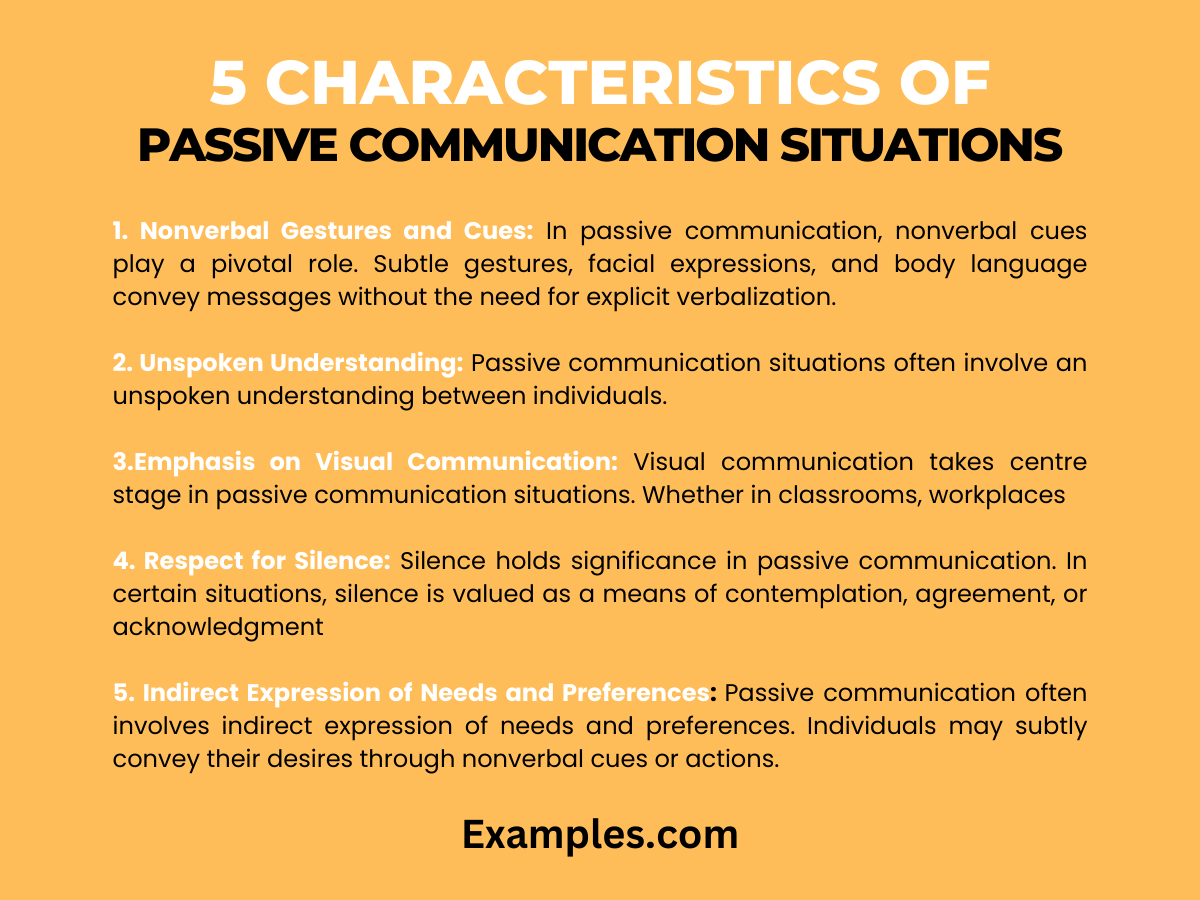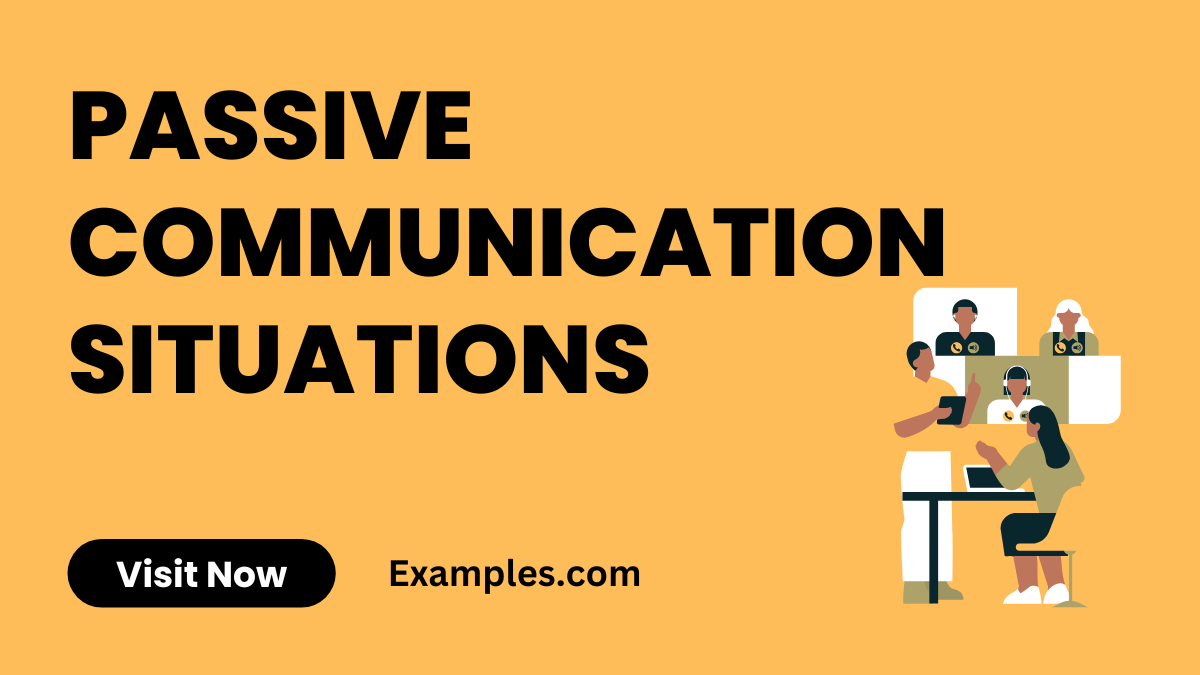19+ Passive Communication Situations Examples
Explore the intricate world of passive communication situations with insights, examples, and actionable tips. Uncover the power of unspoken language, where nuances play a pivotal role in student scenarios. From classroom dynamics to group projects, delve into diverse communication examples that illuminate the art of conveying messages without words. Elevate your communication prowess and master the subtle dance of nonverbal interactions in various student-related situations.
20 Examples of Passive Communication Situations
Unlock the advantages of passive communication in diverse situations with practical examples that highlight its subtle effectiveness. Embrace the power of nonverbal cues, strategic silences, and nuanced expressions for enhanced interpersonal dynamics. Mastering passive communication can foster understanding, prevent conflicts, and contribute to a positive environment. Explore the nuanced benefits through these unique examples.

- Classroom Nod of Agreement: Subtly affirm your understanding during lectures with a nod, fostering a non-disruptive acknowledgment of shared comprehension.
- Office Meeting Observations: Silently observe colleagues’ body language during meetings to gauge reactions and sentiments without interrupting the flow of discussion.
- Team Project Visual Consensus: Utilize visual cues like raised eyebrows or shared glances to signify agreement or disagreement in group projects.
- Public Speaking Supportive Gestures: Express encouragement nonverbally through subtle gestures, like a reassuring smile or nod, during public speaking events.
- Conference Call Muted Agreement: Demonstrate agreement on virtual calls by using muted visual cues, such as nodding or thumbs-up, without verbal interruption.
- Library Group Silent Coordination: Coordinate with group members silently in a library by using hand signals or facial expressions to convey information without disturbing others.
- Interviewee Nonverbal Confidence: Convey confidence in job interviews through controlled body language, showcasing competence without overt verbal self-assurances.
- Restaurant Nonverbal Order Confirmation: Confirm an order nonverbally in a busy restaurant by making eye contact with the server and subtly nodding, ensuring accuracy.
- Workplace Desk Communication: Signal availability or focus at work with subtle cues like an open door or closed workspace, promoting efficient communication.
- Networking Event Approachability Aura: Project approachability in networking events through open body language, encouraging others to initiate conversations.
- Collaborative Project Shared Vision: Demonstrate shared vision in collaborative projects by aligning nonverbal cues, fostering unity without explicit verbalization.
- Parental Silent Understanding: Understand your child’s needs without words by interpreting their nonverbal cues, creating a silent bond of understanding.
- Relationship Emotional Support Gestures: Provide emotional support in relationships through comforting gestures like a gentle touch or empathetic facial expressions.
- Shopping Nonverbal Preferences: Express shopping preferences silently with friends through gestures or expressions, streamlining decision-making without extensive discussion.
- Airport Reunion Silent Excitement: Convey excitement during airport reunions through nonverbal cues, creating an emotional connection without immediate verbal expressions.
- Class Presentation Group Coordination: Coordinate with group members during presentations through nonverbal signals, ensuring a smooth and synchronized delivery.
- Project Deadline Nonverbal Stress: Indicate stress or urgency during project deadlines with subtle cues, prompting team members to prioritize without direct verbal communication.
- Family Gathering Unspoken Traditions: Acknowledge family traditions silently through shared glances or gestures, preserving the essence of unspoken familial connections.
- Apology Acceptance Nonverbal Understanding: Accept apologies nonverbally with a nod or receptive body language, fostering understanding without prolonged verbal exchanges.
- Public Transportation Seating Signals: Efficiently communicate seating preferences on public transportation through nonverbal cues, ensuring a smooth and unspoken arrangement.
Passive Communication Situations for Students
Unlock the subtleties of passive communication in student scenarios. Explore nonverbal nuances that influence interactions, from classroom dynamics to collaborative projects. Elevate your interpersonal skills and thrive in academic settings.
- Classroom Brevity: Signal understanding with a subtle nod during lectures, fostering a silent acknowledgment of shared comprehension.
- Library Study Coordination: Coordinate silently with peers in a library through nonverbal cues, ensuring efficient collaboration without disruption.
- Group Project Nonverbal Agreement: Demonstrate agreement in group projects through visual cues like raised eyebrows or shared glances, fostering unity.
- Student Presentation Supportive Gestures: Express encouragement during student presentations with a reassuring smile or nod, enhancing speaker confidence.
- Virtual Class Muted Approval: Convey agreement in virtual classes through muted visual cues, such as nodding or thumbs-up, without verbal interruption.
- Dorm Room Shared Understanding: Understand your roommate’s needs silently through nonverbal cues, fostering a harmonious living environment.
- Extracurricular Team Visual Consensus: Establish visual consensus in extracurricular teams by using nonverbal signals, ensuring smooth collaboration.
- Seminar Audience Silent Engagement: Engage silently in seminars by demonstrating attentiveness through nonverbal cues, enhancing the learning environment.
- Study Group Unspoken Cooperation: Cooperate seamlessly in study groups through nonverbal understanding, streamlining the exchange of ideas without overt discussion.
- Campus Networking Nonverbal Approach: Approach networking events on campus with open body language, inviting conversations without the need for explicit verbal invitations.
Passive Communication Situations for Employees
Navigate the complexities of passive communication in the workplace. Explore how nonverbal cues and subtle gestures impact employee dynamics, collaboration, and professional relationships.
- Meeting Room Silent Agreement: Convey agreement during meetings through nonverbal cues, such as nods or affirmative gestures, fostering a harmonious work environment.
- Office Collaboration Visual Consensus: Establish visual consensus in collaborative projects through nonverbal signals, ensuring a unified team approach.
- Email Communication Tone: Convey tone effectively in emails through careful selection of words and formatting, maintaining a professional and diplomatic communication style.
- Desk Openness Nonverbal Communication: Signal approachability at work by maintaining an open desk space, fostering communication and interaction among colleagues.
- Project Deadline Nonverbal Stress: Indicate urgency during project deadlines with subtle cues, prompting team members to prioritize tasks without explicit verbal communication.
- Managerial Nonverbal Leadership: Exhibit leadership nonverbally by maintaining confident body language and expressions, instilling confidence in team members.
- Client Meeting Silent Assurance: Assure clients silently during meetings through confident and composed nonverbal cues, conveying reliability and competence.
- Telecommuting Silent Engagement: Engage effectively in virtual meetings by using nonverbal signals like nods and facial expressions, enhancing communication in remote work settings.
- Performance Review Unspoken Feedback: Provide constructive feedback nonverbally during performance reviews through gestures and expressions, creating a supportive environment.
- Team Building Event Silent Bonding: Bond silently during team-building events by using nonverbal cues, fostering camaraderie and connection among employees.
5 Characteristics of Passive Communication Situations
Passive communication situations are rich with unspoken nuances that shape interactions. Understanding the key characteristics can enhance your ability to navigate these scenarios effectively.

1. Nonverbal Gestures and Cues
In passive communication, nonverbal cues play a pivotal role. Subtle gestures, facial expressions, and body language convey messages without the need for explicit verbalization. Recognizing and interpreting these cues is crucial for grasping the underlying dynamics.
2. Unspoken Understanding
Passive communication situations often involve an unspoken understanding between individuals. Shared experiences, cultural background, or established relationships contribute to this silent comprehension, fostering a connection beyond words.
3. Emphasis on Visual Communication
Visual communication takes centre stage in passive communication situations. Whether in classrooms, workplaces, or social settings, visual elements such as eye contact, nods, and gestures become powerful tools for conveying thoughts and feelings.
4. Respect for Silence
Silence holds significance in passive communication. In certain situations, silence is valued as a means of contemplation, agreement, or acknowledgment. Recognizing when silence is appropriate is key to navigating these scenarios effectively.
5. Indirect Expression of Needs and Preferences
Passive communication often involves indirect expression of needs and preferences. Individuals may subtly convey their desires through nonverbal cues or actions, requiring astute observation to comprehend these preferences without explicit verbal communication.
In conclusion, mastering passive communication situations is an art that goes beyond words. With subtle nonverbal cues, unspoken understanding, and an emphasis on visual communication, individuals can navigate diverse scenarios effectively. Recognizing the characteristics of passive communication empowers one to decipher the silent language, fostering meaningful connections and interactions in various aspects of life.



